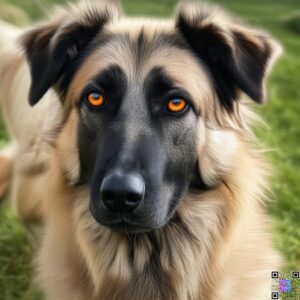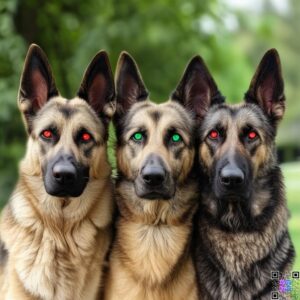Introduction
The Anatolian Shepherd, a majestic breed hailing from the rugged landscapes of Turkey, has long captivated the hearts of dog enthusiasts worldwide. While these noble canines are renowned for their strength, loyalty, and protective instincts, their eye color is a fascinating aspect that adds to their allure. From the warm amber hues to the rare and captivating blue eyes, the Anatolian Shepherd’s gaze reflects the breed’s genetic diversity and unique charm.
Exploring the Genetic Diversity of Anatolian Shepherds

Anatolian Shepherds, like all dogs, possess a rich tapestry of genetic traits that contribute to their distinctive appearance and temperament. The breed’s eye color is a prime example of this genetic diversity, with the majority of Anatolian Shepherds boasting the traditional brown or amber eyes. However, the occasional appearance of blue eyes within the breed has sparked curiosity and fascination among dog enthusiasts.
Understanding the Rarity of Blue Eyes in the Breed
While blue eyes are a relatively common trait in some canine breeds, they are considered a rarity in Anatolian Shepherds. This unique characteristic is the result of complex genetic factors, including mutations and variations that can influence the production and distribution of melanin, the pigment responsible for eye color. The scarcity of blue-eyed Anatolian Shepherds adds to their allure and makes them a true standout within the breed.
Factors Contributing to Unique Eye Color Variations
The diverse range of eye colors observed in Anatolian Shepherds can be attributed to a combination of genetic factors. The interplay between dominant and recessive genes, as well as the presence of genetic mutations, can lead to the emergence of unique eye color variations. Understanding these underlying mechanisms provides valuable insights into the breed’s genetic makeup and the factors that contribute to its captivating visual diversity.
Decoding Anatolian Shepherd Eye Color Genetics
Delving into the genetic foundations of Anatolian Shepherd eye color reveals a fascinating world of canine genetics. By exploring the role of melanin, the dominant and recessive genes at play, and the potential impact of genetic mutations, we can gain a deeper appreciation for the breed’s diverse visual characteristics.
The Role of Melanin in Canine Eye Color
Mammalian pigmentation, including the eye color of dogs, is primarily determined by the presence of melanin, a skin pigment. There are two main types of melanin: eumelanin, which produces black and brown hues, and phaeomelanin, responsible for yellow and red tones. The balance and distribution of these pigments within the iris contribute to the wide range of eye colors observed in Anatolian Shepherds and other dog breeds.
Dominant and Recessive Genes Influencing Eye Color
The inheritance of eye color in Anatolian Shepherds, as in all dogs, is governed by a complex interplay of dominant and recessive genes. Certain gene variants, when present in a dominant form, can result in the more common brown or amber eyes, while the presence of recessive gene variants can lead to the rare occurrence of blue eyes. Understanding these genetic mechanisms provides valuable insights into the breed’s diverse visual characteristics.
Genetic Mutations and Their Impact on Eye Color
In addition to the influence of dominant and recessive genes, genetic mutations can also play a role in the emergence of unique eye color variations within the Anatolian Shepherd breed. These mutations can alter the production or distribution of melanin, leading to the appearance of less common eye colors, such as the captivating blue eyes that have been observed in some Anatolian Shepherds.
Embracing the Beauty of Anatolian Shepherd Blue Eyes
The presence of blue eyes in Anatolian Shepherds, though rare, adds an enchanting and captivating element to the breed’s visual diversity. As owners and enthusiasts explore this unique trait, they are often left in awe of the striking contrast between the breed’s imposing stature and the delicate beauty of their blue-eyed gaze.
The Allure of Blue-Eyed Anatolian Shepherds
The striking appearance of a blue-eyed Anatolian Shepherd is a sight to behold, capturing the attention of dog lovers and breed enthusiasts alike. The unexpected and captivating combination of the breed’s strong, protective presence and the delicate, almost ethereal quality of their blue eyes creates a visual juxtaposition that is both intriguing and endearing.
Potential Health Considerations for Blue-Eyed Anatolian Shepherds
While the presence of blue eyes in Anatolian Shepherds is generally harmless, owners should be mindful of potential health considerations. Blue-eyed dogs, including Anatolian Shepherds, may be more susceptible to certain eye-related conditions, such as increased light sensitivity or a higher risk of eye injuries. Responsible owners should work closely with their veterinarians to ensure the overall well-being of their blue-eyed canine companions.
Acceptance and Perception in the Breed Community
The emergence of blue-eyed Anatolian Shepherds has sparked discussions and debates within the breed community. While some enthusiasts embrace the unique trait as a testament to the breed’s genetic diversity, others may have concerns about its potential impact on breed standards and conformation. Navigating these perceptions and fostering a greater understanding of the blue-eyed Anatolian Shepherd is an ongoing challenge for owners and breeders alike.
Responsible Ownership and the Anatolian Shepherd
Owning an Anatolian Shepherd, regardless of eye color, comes with a unique set of responsibilities. Ensuring the well-being and happiness of these noble canines requires a deep understanding of their breed-specific needs and a commitment to providing them with the care and attention they deserve.
Prioritizing the Unique Needs of Anatolian Shepherds
Anatolian Shepherds are a breed with distinct characteristics and requirements. From their protective instincts to their need for ample exercise and socialization, responsible owners must be prepared to cater to the specific needs of these impressive guardians. Whether the Anatolian Shepherd has traditional brown or amber eyes, or the captivating blue eyes, the commitment to their overall well-being remains paramount.
Ensuring Proper Socialization and Training
Anatolian Shepherds, with their strong protective instincts, require a thoughtful approach to socialization and training. Exposing these dogs to a variety of environments and experiences, from a young age, helps to temper their guarding tendencies and foster a more adaptable and well-rounded companion. Responsible owners must invest time and effort into this crucial aspect of Anatolian Shepherd ownership, ensuring the breed’s unique temperament is nurtured and channeled in a positive direction.
Fostering a Harmonious Relationship with Blue-Eyed Anatolian Shepherds
Owning a blue-eyed Anatolian Shepherd presents an opportunity to celebrate the breed’s genetic diversity and forge a deep, meaningful bond. By understanding the unique considerations and potential challenges associated with blue eyes, owners can create a harmonious and fulfilling relationship with their canine companions. Through proper care, training, and a commitment to the breed’s well-being, blue-eyed Anatolian Shepherds can thrive as beloved members of the family.
Specific Genes Affecting Anatolian Shepherds
Research indicates that specific genes are responsible for determining eye color in Anatolian Shepherds. The presence of certain alleles—variations of a gene—can lead to variations in pigmentation. For example:
- The B gene, which influences brown pigment production.
- The D gene, which affects dilution and can lead to lighter shades.
- Other modifiers may also play a role in creating unique combinations.
By understanding these genetic components, breeders can make informed decisions when selecting breeding pairs to achieve desired traits while maintaining overall health.
Signs of Eye Problems to Watch For
Being vigilant about your dog’s eye health means recognizing potential issues early on. Some signs that may indicate an eye problem include:
- Excessive tearing or discharge
- Redness or swelling around the eyes
- Cloudy or cloudy appearance
- Squinting or pawing at the eyes
If you notice any of these symptoms, it’s crucial to consult with your veterinarian promptly. Early intervention can prevent more severe complications down the line.

Frequently Asked Questions (FAQs)
1- Are blue eyes common in Anatolian Shepherds?
No, blue eyes are considered a rare occurrence in Anatolian Shepherds. The breed is predominantly known for its brown and amber eye colors, with the appearance of blue eyes being an uncommon genetic variation.
2- Do blue-eyed Anatolian Shepherds have any health issues?
While the presence of blue eyes is generally harmless, blue-eyed Anatolian Shepherds may be more susceptible to certain eye-related conditions, such as increased light sensitivity or a higher risk of eye injuries. Responsible owners should work closely with their veterinarians to monitor the overall health and well-being of their blue-eyed canine companions.
3- Can blue-eyed Anatolian Shepherds participate in dog shows?
The acceptance of blue eyes in Anatolian Shepherd dog shows may vary depending on the specific breed standards and regulations set by the organizing bodies. Owners of blue-eyed Anatolian Shepherds should consult with breed organizations to understand the current guidelines and requirements for participation.
4- How do I identify an Anatolian Shepherd with blue eyes?
Anatolian Shepherds with blue eyes can be identified by their striking, light-colored irises that contrast with the breed’s more common brown and amber eye tones. The blue eyes may range from a pale, icy hue to a deeper, more vibrant shade, adding to the captivating appearance of these unique canines.
5- What are the potential causes of blue eyes in Anatolian Shepherds?
The presence of blue eyes in Anatolian Shepherds can be attributed to various genetic factors, including mutations and variations in the genes responsible for melanin production and distribution. These genetic factors can lead to the reduced or altered production of melanin, resulting in the appearance of blue eyes within the breed.
6- How do I care for a blue-eyed Anatolian Shepherd?
Caring for a blue-eyed Anatolian Shepherd requires the same level of dedication and attention as caring for any Anatolian Shepherd. Responsible owners should prioritize the breed’s unique needs, including proper nutrition, exercise, socialization, and training. Additionally, owners may need to take extra precautions to protect their blue-eyed companions from potential eye-related issues, such as increased light sensitivity.
Conclusion
The captivating world of Anatolian Shepherd eye colors is a testament to the breed’s genetic diversity and the wonders of canine genetics. From the warm, familiar brown and amber hues to the rare and enchanting blue eyes, these majestic guardians continue to captivate the hearts of dog enthusiasts worldwide. By embracing the unique traits and characteristics of Anatolian Shepherds, regardless of eye color, owners and enthusiasts can foster a deeper appreciation for the breed’s enduring legacy and the beauty that lies within.
